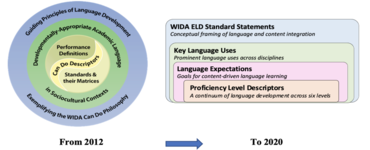The purpose of this study is to examine how elements of systemic infrastructure for multilingual success (SIMS) contributed to English as a Second Language (ESL) teachers’ ability to engage in language instruction during emergency remote teaching and learning (ERTL) in the initial months of the COVID-19 pandemic when schools were transitioning to distance learning. Focused on the Great Lakes region, we utilized surveys and interviews to learn about the roles and responsibilities of ESL teachers during this critical transition. Findings illuminate the generative effects of existing SIMS such as collaboration and co-teaching, ESL leadership, and technology as well as the negative approaches to school infrastructure such as combined teacher/coordinator roles and at-will educator employment. Implications for systemic school reform for multilingual learner equity are discussed.
Keywords: English learners, COVID-19, Instruction, service, infrastructure, multilingual, remote
In 1981, the Castañeda v. Pickard case established a three-part framework to evaluate the efficacy of school district English as a Second Language (ESL) service programs. Thirty years later, the expectations specified in that case have been put to the ultimate test: a global pandemic. With almost five million students categorized as English Learners nation-wide (Mitchell, 2020) and an education system experiencing strain like never before, this article will illuminate how well our schools were able to adhere to the stipulations of Castañeda v. Pickard during emergency remote teaching and learning (ERTL).
The focus of the present study is on systemic infrastructure for multilingual success (SIMS) in the Great Lakes Region of the U.S., including Minnesota, Wisconsin, and Indiana. While these states have similar profiles when it comes to immigrant and refugee populations (U.S. Department of Education, n.d.), they have vastly different structures and policies in place when it comes to ESL education. Given these conditions, the research question guiding this analysis is: Which elements of SIMS afforded the least disrupted language learning experience during ERTL?
At the time of data collection, Minnesota had the most robust SIMS of the three states with the most comprehensive multilingual learner (MLL) legislation in the nation—The Minnesota Learning English for Academic Proficiency and Success [LEAPS] Act, 2014—rigorous teacher licensing requirements consisting of a stand-alone license of approximately 30 credit hours and mostly at the graduate level (M. Sandler, personal communication, September 2, 2021), and one of the largest state ESL teacher professional organizations in the nation, MinneTESOL (an affiliate of TESOL International Association). In addition, one of the researchers conducting this study, Michelle Benegas, is the principal investigator on a National Professional Development grant from the U.S. Department of Education called The English Learners in the Mainstream (ELM) Project. The ELM Project has prepared over 400 licensed ESL teachers across the state to serve as teacher leaders who provide professional development and coach their general education colleagues on promising practices for MLLs. In partnership with public districts, public charters, and private schools in urban, suburban, and rural communities, the ELM Project has increased the collective preparation of general educators across the state to better serve MLLs as well as the capacity of ESL teachers to serve as site-based instructional leaders. This manuscript will focus on data collected from Minnesota participants of the larger study to highlight how a state with strong SIMS carried out the expectations of historic supreme court cases and the Minnesota state LEAPS Act (2014).
Terminology
The term “ESL teacher” is used throughout this article, as this reflects Minnesota state licensure requirements. While the state continues to use the term “English learner” or “EL” to refer to students acquiring English, we have opted to refer to these students as “multilingual learners” or “MLLs” to validate and celebrate the assets they bring to the classroom. “Instruction” refers to language and/or literacy support that facilitates access to academic content. “Service” refers to any non-instructional support that facilitates daily living or access to instruction.
Literature review and background
Building SIMS
U.S. MLL education policy is sparse and sporadically adhered to. However, one doesn’t need to look far to find an alternative. U.S. special education policy, for example, garners bipartisan support, statutorily limits teacher caseloads, specifies student contact hours as well as service models, and requires a legally binding contract that is required to be re-evaluated annually. McGill (2000) highlights the ways in which ESL programs are positioned as subordinate in school curriculum and draws parallels to the ways in which immigrants are marginalized in society. Additionally, there is research to support the claim that such marginalization of MLLs also manifests as marginalization of ESL teachers (Arkoudis, 2006; Davison, 2006; McClure & Cahnmann-Taylor, 2010). Nation-wide, the trend has been for ESL teachers to be positioned as reading specialists, classroom assistants, and interventionists (Harper et al., 2008).
Given the impact of systemic racism on MLLs and the resulting diminished perception of ESL teachers, building effective school infrastructure is a significant challenge (Spillane et al., 2011). School infrastructure refers to “the resources that support school leaders and teachers in providing high-quality instruction” (Hopkins et al., 2015). Developed by the researcher for this investigation, the heuristic guiding analysis in this article is SIMS. The elements of SIMS are the following:
- Informed: ESL teachers have robust preparation; general education teachers and support staff have continuous professional development on promising practices for MLLs; and MLL leaders have ESL teacher credentials in addition to years of experience in the classroom.
- Proactive: Support systems are in place prior to a schooling disruption.
- Collaborative: Responsibility for MLLs’ success is shared across district/school sectors (social work, information technology, nurse, nutrition services, general education teachers, ESL teachers, etc.).
- Distributed: Decision-making and leadership for MLLs are shared by a variety of professionals with MLL expertise.
- Responsive: Support systems for MLLs are based on a continuous cycle of improvement and staff are provided ongoing professional development to respond to changing needs.
Building adequate and appropriate SIMS is particularly challenging in communities with rapidly changing student populations. Minnesota has more refugees per capita than any other state (Shaw, 2018), most of whom have been relocated in the last thirty years. This rapid demographic shift necessitated strong enough SIMS to withstand strain on the education system to avert a negative impact on MLLs during ERTL.
ERTL and the COVID-19 pandemic
ERTL is the response to a disruption in the predominant educational model. This disruption could be the result of political, economic, social, or environmental instability (Davies & Bentrovato, 2011; Milman, 2020). ERTL is distinct from typical online teaching and learning, in which school infrastructure is designed for a virtual format ahead of time and not during a time of crisis (Affouneh et al., 2020; Hodges et al., 2020; Milman, 2020).
In the case of the COVID-19 pandemic, in the months of March, April, May, and June of 2020, teachers and other school leaders were called to make significant, abrupt changes as they transitioned to distance learning. During this time, the role and responsibilities of ESL teachers varied widely. Depending on the existing infrastructure in place to support MLLs, ESL teachers adapted and, in some cases, were unable to adequately attend to instruction as their attention was directed toward service-related tasks in order to ensure that their students had adequate shelter, food, healthcare, technology, and access to WiFi. This study sought to highlight how ESL teachers assumed, negotiated, and resisted instruction and service-related tasks during ERTL (Morita-Mullaney & Stalling, 2018).
Methodology
This two-phase case study draws from data collected via 405 completed surveys and 60 semi-structured interviews of ESL teachers conducted between the months of April and June, 2020. The hallmark of case study research is the bounded unit of analysis, otherwise known as the case. Hamel et al. (1993) assert that the goal of case study research is the reconstruction and analysis of a case from a sociological perspective. Similarly, Johnson and Christensen (2008) maintain that case study research is “research that provides a detailed account and analysis of one or more cases” (p. 406). In case study research, the case is determined based on the question(s) that the researcher seeks to answer. Yin (2014) explains that a case is a unit of analysis, which may be an individual, an event or entity. Stake (2006) furthers that each case can be a “bounded system” in that it is made up of interrelated components or characteristics that have identifiable boundaries. Data were analysed for evidence of SIMS in place prior to the start of the pandemic in order to evaluate which SIMS are effective in providing MLLs with uninterrupted language learning and which infrastructural approaches are ineffective. For the purpose of this study, we narrow in on the state of Minnesota drawn from a larger scale study (Cushing-Leubner et al., 2021; Morita-Mullaney et al., 2021).
Participants
Study participants were recruited according to readily available teacher contact information in each state. In Indiana and Minnesota, surveys were distributed to the membership of each state’s TESOL affiliate. TESOL International is the predominant professional organization in the field of ESL. As such, MinneTESOL (Minnesota) and INTESOL (Indiana) facilitated the distribution of surveys to practicing K-12 ESL teachers in public district, public charter, and private schools in Minnesota and Indiana. Minnesota also utilized The ELM Project listserv to distribute surveys. In the state of Wisconsin, schools with ESL programs were identified using the Department of Public Instruction list of school districts and teachers, and participants were solicited using the emails listed on their school websites. Participants were novice and experienced ESL teachers.
Data collection: Surveys
A survey was divided into three sections: teacher and school demographic information, ESL teacher instruction provided before and during ERTL, and ESL teacher services provided before and during ERTL. The multiple choice survey was created using Qualtrics and shared via hyperlink. At the end of the survey, participants were given the opportunity to volunteer to participate in a follow-up interview. Data were disaggregated by state to examine patterns across these demographically similar contexts. While this study starts with an overview of the three states, its main focus is on the state of Minnesota, where SIMS looks different compared to other Midwest states studied (Indiana and Wisconsin). Of the 405 ESL teachers that responded, 47% were Minnesota teachers.
Data collection: Interviews
The semi-structured interviews were conducted via Zoom and WebEx. Data were transcribed using Zoom and WebEx as well. Interview questions were focused on the categories of instruction and service. Items related to instruction focused on frequency, methods of delivery, and content of instruction. In the area of service, items pertained to ways in which ESL teachers served ELs in non-instructional ways. Participants also reported the percentage of time that they spent working on instruction compared to the percentage of time that they spent working on service prior to and during ERTL. Finally, they were asked to consider how they may have been positioned to carry out these instructional and service roles. Of the 60 follow-up interviews that were conducted, Minnesota ESL teachers represented 45% of the total number of participants.
Data analysis
Data were coded and analysed using NVivo software. We utilized thematic coding to examine how ESL teachers assumed, negotiated and resisted particular instruction and service-related tasks during ERTL. Teachers who assumed tasks did what they were asked to do. Teachers who negotiated tasks voiced their opinions and found a middle ground. Teachers who resisted tasks refused to engage in tasks based on principle or bandwidth. The heuristic guiding this article is the five elements of SIMS which are: 1) informed, 2) proactive, 3) collaborative, 4) distributed, and 5) responsive.
Findings: Effective SIMS
This investigation demonstrated that quality MLL programming is not dependent on the number of MLLs served, rather the infrastructure that is in place. Through coding and analysis of the data, three themes emerged as features of systems that are aligned with the five elements of SIMS. SIMS functions with: 1) expert professionals in a distributed leadership model; 2) collaboration and co-teaching; and 3) technology support in place. While this study didn’t seek to find infrastructural elements that impeded ESL teachers’ ability to provide uninterrupted language instruction during ERTL, two emerged. They are presented below as examples of ineffective infrastructure for multilingual learners.
Expert professionals in a distributed leadership model
This finding attends to the first and fourth elements of SIMS: informed and distributed. These systems are informed by experts in the field and leadership responsibilities are shared amongst colleagues. In the case of K-12 schooling, leadership responsibilities can be taken up by the building principal, assistant principal, district level ESL coordinator, multicultural liaison, teacher, and other staff. When schools had this element of SIMS in place, ESL teachers were also more apt to be able to carry out instruction during ERTL. One teacher participant reported:
Our ELL coordinator was very instrumental. We had weekly check ins with her… She has the ear of the curriculum and instruction people at the district… so if issues came up, she could bring them up at the district level too.
Reflecting on school-level leadership structures, another teacher shared:
Oh my principal is the most supportive principal I’ve ever had. I, which is why I’m never leaving… I also had weekly check-ins with my coach to help me work through any issues.
Finally, this participant expresses that she works on a high functioning collaborative leadership team when she says:
I feel like I’m very fortunate. I have a support staff. If I reach out to an assistant principal and say, ‘This needs to happen’, it will get done… We’ve been able to get tons of help. And everybody is definitely, at least in my building, in my experience, 100% there to make sure that the [MLLs] are getting what they need.
The above selections from participant interviews illustrate how a distributed leadership model can offer a web of support to be accessed when needed, relieving the ESL teacher from the pressure they may feel to be the be-all and end-all for MLLs in their classes.
Collaboration and co-teaching
The third element of SIMS is that they are collaborative. In schools with a collaborative approach to service and instruction, ESL teachers reported little disruption to their language instruction at the onset of ERTL. One element of SIMS that presented itself repeatedly in the data is a collaboration and co-teaching model. One teacher reported:
We meet non-stop. I feel like we’re texting and talking in PLC all the time… So the five of us kind of just work together to make sure that we’re hitting different areas where we’re focusing with different students.
Whereas some co-teaching models fall short when it comes to collaboration and co-planning, this team is cohesive and connected. When the responsibilities are spread out over a team of teachers, they are more successful in meeting the needs of all learners. Teacher relationships like those described above develop over time. One participant shared:
I’ve been a teacher for a long time. I’ve been a co-teacher for a long time. And it’s one of those times where all of a sudden… all the things fall in place. The guy I co-teach with, he and I taught [together] for seven years and it was like, “Oh my God we’re doing it, we’re doing like, what you read about.”
This participant refers to the rationale beyond collaboration and co-teaching as an element of SIMS—to reinforce the MLL language learning experience so that it is continuous, uninterrupted, and impermeable to factors outside of the classroom.
Technology support in place
The second element of SIMS is that they are proactive. Technology and technology support facilitated learning environments where ESL teachers were able to carry out uninterrupted language instruction. The proactive aspects of technology that were reported to improve ERTL are:
- a learning management system (LMS) in place prior to the start of the pandemic;
- one-to-one devices for all students;
- a non-instructional technology department that can assist with hardware as well as WiFi;
- and teachers and students who have a high level of digital literacy.
A critical component to a smooth transition to distance learning was an LMS in place prior to the transition to ERTL. While many secondary students were already skilled LMS users, few elementary schools had them in place in March of 2020. Dedicated technology support was also critical to ensuring teachers had the bandwidth to provide instruction to MLLs during this time. Many teacher participants in this study reported sacrificing hours of instructional time in lieu of student tech support. One teacher shared how this infrastructure allowed her to do her job when students needed her the most. She shares:
When we’ve needed technical support, our administration is on top of it to make sure that things are delivered in a timely manner and following up to make sure that it doesn’t go into the black hole of service tickets.
Schools with technology support infrastructure in place allowed MLLs to engage in more uninterrupted instructional time.
By far, the most challenging aspect of technology during ERTL was the lack of reliable WiFi. The pandemic revealed how many families were without connectivity and the support that these families needed so that their children could participate in school was significant. Whereas some teacher participants were struggling to negotiate with the local cable company on the weekends, another remarked:
We had a cultural liaison that would literally go to the apartment complex and help these kids get it hooked up because, if after multiple calls and multiple times, the kids just were not able to get it hooked up for whatever reason, he finally just went to the house and hooked it up.
The COVID-19 pandemic demonstrated that access to technology is a basic need, not a privilege. When students have this basic need met, their academic experience is less likely to be impacted during a time of crisis.
Findings: Ineffective infrastructure for MLLs
While the aim of this article is on SIMS that improved ESL teachers’ ability to focus on instruction during ERTL, there were also examples of approaches to school infrastructure that bore out negatively when it came to ESL teachers’ instructional bandwidth. The data show two structural aspects that negatively impacted the continuous language learning experience for MLLs during ERTL. It is significant that data from both of these findings were present exclusively amongst ESL teachers in charter schools.
Dual teacher – MLL coordinator role
Data revealed that a number of ESL teacher participants in charter schools are asked to wear multiple hats—they may serve instructional as well as administrative roles, without adequate time built into the day or provisions in place to prevent disruptions to MLL language instruction. In the case of ERTL, schools with pre-existing limited capacity to support MLLs that assigned one person to multiple roles, such as school-wide MLL coordinator and ESL teacher, experienced impeded possibility for collaborative and distributive SIMS. MLLs benefit from teams of professionals who are committed to their best interests. In the absence of a professional team, dual role professionals will defer to administrative tasks and sacrifice instruction. Educators in these roles reported that they were often unable to provide direct instruction to MLLs during ERTL due to time constraints. Sometimes these roles were assumed and sometimes they were ascribed. Highlighting the complexity and demand of the position, one teacher/coordinator shared her duties in addition to teaching:
I also serve as the EL coordinator, which has some coaching. I’m also our school district assessment coordinator and migrant liaison… I’m the first point of contact for a lot of our immigrant families and so I help students access internet, access housing, access food.
Throughout the interview transcripts, professionals in these dual roles referred to themselves as “therapist,” “mother,” and “social worker”—roles that they didn’t feel prepared to carry out. They witnessed students struggle as a result of the limited school support and often took that on as a personal failure. One teacher/coordinator reflected on their instructional delivery being reduced to sporadic homework help:
It was just… horrible. I didn’t hear from three of my level ones [WIDA Proficiency Levels], the entire time… They would pull up their assignment, and I would just come up with something on the fly…It was just absolutely horrible—not proud of anything I did.
In many cases, dedicated language instruction goals were eliminated entirely from MLLs’ schedules and ESL teachers were relegated to attend exclusively to general education goals. Perhaps the most poignant comment from a teacher/coordinator was:
So I honestly did not do very much instruction… And I think that our whole distance learning process was very inequitable, especially towards our language learners.
Study participants were cognizant of the ways in which MLLs were being provided a sub-par learning experience but it was out of their locus of control.
At-will educator employment
In the state of Minnesota, the vast majority of teachers in charter schools have at-will teaching contracts, which means that they can be dismissed at any time without advance notice and are without access to tenure or union representation (Eischens, 2021; Resilient Educator Editorial Team, 2021). Participants in this study illustrated the strain that they experience due to these conditions. Feeling frustrated and unappreciated, one teacher/coordinator shared:
And nobody else really even understands, so they just kind of treat us like a hot potato.
Certainly, this falls in stark contrast to the second and third elements of SIMS, which are that they are proactive and collaborative. In line with previous findings, another participant reported being misunderstood by their colleagues and indentured to general education support:
I just positioned myself as, “All right, let’s get all of you across the finish line in your other classes. Let’s not focus on this one [EL class].” And I think I was forced into that position by other staff members, just because they were not going to accommodate or modify anything.
The perception of being misunderstood escalated in one case to an ESL teacher feeling threatened by general education colleagues. This teacher remarked:
There are teachers in the building that when I try to remind them there’s an [individual language plan] and the students are entitled to accommodations that I get screamed at and cussed at in front of students. So yes, it’s pretty regular that I have to do that. And pretty regular that kids won’t get service because that’s not what I want to risk my career over today, you know?
Not only did this participant feel threatened by her colleagues in the classroom, she also felt that their employment could be compromised if they advocated for MLLs.
It was apparent in the data from teachers at charter schools that they often made instructional decisions cognizant of the unprotected nature of their teaching positions. As teachers without union support or the possibility of tenure, they are at-will and can be terminated at any time. In the vast data set collected for this study across three states, there is just one example of a charter school teacher resisting an instructional decision and there are no examples of a charter school teacher resisting a service-related task. This degree of tension has the potential to result in high teacher turnover, which limits the collective expertise of a teaching faculty, thus hindering the first element of SIMS, which is that educators are informed.
Conclusion
In cases where SIMS was ineffective, language instruction was de-emphasized as MLLs, already struggling and marginalized, found themselves unable to meet their most immediate needs—shelter, food, and healthcare. During this time, ESL teachers worked tirelessly to support their students in any way that they were needed. They delivered food, arranged for home WiFi for families, accompanied students to the hospital when they were sick, and one even spearheaded a fundraiser that collected $10,000 to support MLL families who were in jeopardy of losing their homes. This is important work. This is critical work. ESL teachers should not be in the position to choose whether to offer support needed for survival or to provide language instruction. When schools have SIMS in place such as distributed leadership, technology support, and a model for teacher collaboration, teachers are able to fully dedicate themselves to what they have been prepared to do—provide MLLs with the linguistic tools they need to thrive in school.
Access to grade-level content is a right in U.S. schools. Supreme Court rulings on Lau v. Nichols (1974) and Castañeda v. Pickard (1981) established that schools must provide students identified as English learners with language support. Areas for future research include application of the SIMS heuristic to research in different school settings to better understand the relationship between infrastructure, teacher practice, and MLL experience/outcomes and reveal additional SIMS that contribute to uninterrupted language learning for MLLs. Additionally, further examination of the unequal access to MLL language instruction in charter vs. public schools revealed in this investigation is needed to better understand how state and federal policies may inadvertently allow for loopholes that sacrifice student learning.
ERTL illuminated and exacerbated some equity gaps that we can learn from moving forward. The COVID-19 pandemic was not the first wide-scale crisis that has impacted schooling and it will not be the last. Findings will have significance for (1) district and school-level strategic design for MLL school-wide support and (2) federal and state policies about SIMS that adhere to existing federal law by protecting the roles of ESL teachers and the rights of MLLs. MLLs deserve to have safe, healthy lives and the support needed to succeed in content-area classrooms. We can achieve this by building systemic infrastructure strong enough to withstand the next crisis without the education of MLLs being a casualty.
References
Affouneh, S., Salha, S., & Khlaif, Z.N. (2020). Designing quality e-learning environments for emergency remote teaching in coronavirus crisis. Interdisciplinary Journal of Virtual Learning in Medical Sciences, 11(2), 135-137. https://doi.org/10.30476/IJVLMS.2020.86120.1033
Arkoudis, S. (2006). Negotiating the rough ground between ESL and mainstream teachers. International Journal of Bilingual Education and Bilingualism, 9(4), 415-433. https://doi.org/10.2167/beb337.0
Castañeda v. Pickard, 648 F.2d 989. (1981).
Cushing-Leubner, J., Morita-Mullaney, T., Greene, M. C. S., Stolpestad, A., & Benegas, M. (2021). The (im)possibilities of equitable education of multilingual emergent bilinguals in remote teaching: a survey of English language teachers in the Great Lakes region. Planning and Changing Journal, 50(3/4), 139-164. Retrievable from: https://education.illinoisstate.edu/downloads/planning/Cushing_PandC_50.3-4.pdf
Davies, L., & Bentrovato, D. (2011). Understanding education’s role in fragility: Synthesis of four situational analyses of education and fragility in Afghanistan, Bosnia and Herzegovina, Cambodia, Liberia. UNESCO. http://education4resilience.iiep.unesco.org/en/node/957
Davison, C. (2006). Collaboration between ESL and content teachers: How do we know when we are doing it right? International Journal of Bilingual Education and Bilingualism, 9(4), 454-475. https://doi.org/10.2167/beb339.0
Eischens, R. (2021, June 11). Two Minnesota charter schools vote to unionize. Minnesota Reformer. Accessed 23 November 2021 at https://minnesotareformer.com/briefs/two-minnesota-charter-schools-vote-to-unionize/
Johnson, R., & Christensen, L. (2014). Educational research: Quantitative, qualitative, and mixed approaches. Sage Publications.
Hamel, J., DuFour, S., & Fortin, D. (1993). Case study methods. Sage Publications.
Harper, C. A., de Jong, E. J., & Platt, E. J. (2008). Marginalizing English as a second language teacher expertise: The exclusionary consequence of No Child Left Behind. Language Policy, 7(3), 267-284. https://doi.org/10.1007/s10993-008-9102-y
Hodges, C., Moore, S., Lockee, B., Trust, T., & Bond, A. (2020, March 27). The difference between emergency remote teaching and online learning. Educause Review. Accessed 23 November 2021 at https://er.educause.edu/articles/2020/3/the-difference-between-emergency-remote-teaching-and-online-learning
Hopkins, M., Lowenhaupt, R., & Sweet, T. M. (2015). Organizing English learner instruction in new immigrant destinations: District infrastructure and subject-specific school practice. American Educational Research Journal, 52(3), 408-439. https://doi.org/10.3102/0002831215584780
Lau v. Nichols, 414 U.S. 563. (1974).
McClure, G., & Cahnmann-Taylor, M. (2010). Pushing back against push-in: ESOL teacher resistance and the complexities of coteaching. TESOL Journal, 1(1), 101-129. https://doi.org/10.5054/tj.2010.214883
McGill, S. (Ed.). (2000). Language and marginality. Intellect Books
Milman, N. (2020, March 30). This is emergency remote teaching, not just online teaching. Education Week. Accessed 23 November 2021 at https://www.edweek.org/leadership/opinion-
this-is-emergency-remote-teaching-not-just-online-teaching/2020/03
Milman, N.B. (2020, March 25). Pandemic pedagogy. Phi Delta Kappan. Accessed 23 November 2021 at https://kappanonline.org/pandemic-pedagogy-covid-19-online-milman/
Mitchell, C. (2021, February 18). The nation’s English-learner population has surged: 3 things to know. Education Week. Accessed 23 November 2021 at https://www.edweek.org/leadership/the-nations-english-learner-population-has-surged-3-things-to-know/2020/02
Morita-Mullaney, T., Greene, M. C. S., Cushing-Leubner, J., Benegas, M., & Stolpestad, A. (2021). COVID-19 and pandemic teaching: Emergency remote teaching and learning and English learner teachers. Indiana TESOL Journal, 18(1), 25-50. https://doi.org/10.18060/25273
Morita-Mullaney, T., & Stallings, L. (2018). Serving Indiana’s emergent bilingual immigrant (EBI) youth: A collective case study of EBI teacher educators. The Teacher Educator, 53(3), 293-312. https://doi.org/10.1080/08878730.2018.1462422
Resilient Educator Editorial Team. (2021, April 12). Pros and cons of teaching at a charter school. Resilient Educator. Accessed 23 November 2021 at https://resilienteducator.com/teaching-careers/pros-and-cons-of-teaching-at-a-charter-school/
Shaw, B. (2018, January 13). Minnesota has the most refugees per capita in the U.S. Will that continue? Pioneer Press. Accessed 23 November 2021 at https://www.twincities.com/2018/01/13/the-not-so-welcome-mat-minnesota-winces-at-refugee-cutbacks/
Spillane, J. P., Parise, L. M., & Sherer, J. Z. (2011). Organizational routines as coupling mechanisms: Policy, school administration, and the technical core. American Educational Research Journal, 48(3), 586–619. https://doi.org/10.3102/0002831210385102
Stake, R. (2006). Multiple case study analysis. The Guilford Press.
The Minnesota Learning English for Academic Proficiency and Success (LEAPS) Act, Chapter 272 § H.F.No. 2397. (2014). Accessed 23 November 2021 at https://www.revisor.mn.gov/laws/2014/0/Session+Law/Chapter/272/
U.S. Department of Education. (n.d.). Our nation’s English learners: What are the characteristics? Accessed 23 November 2021 at https://www2.ed.gov/datastory/el-characteristics/index.html#four
Yin, R. (2014). Case study research: Design and methods (5th ed.). Sage.












